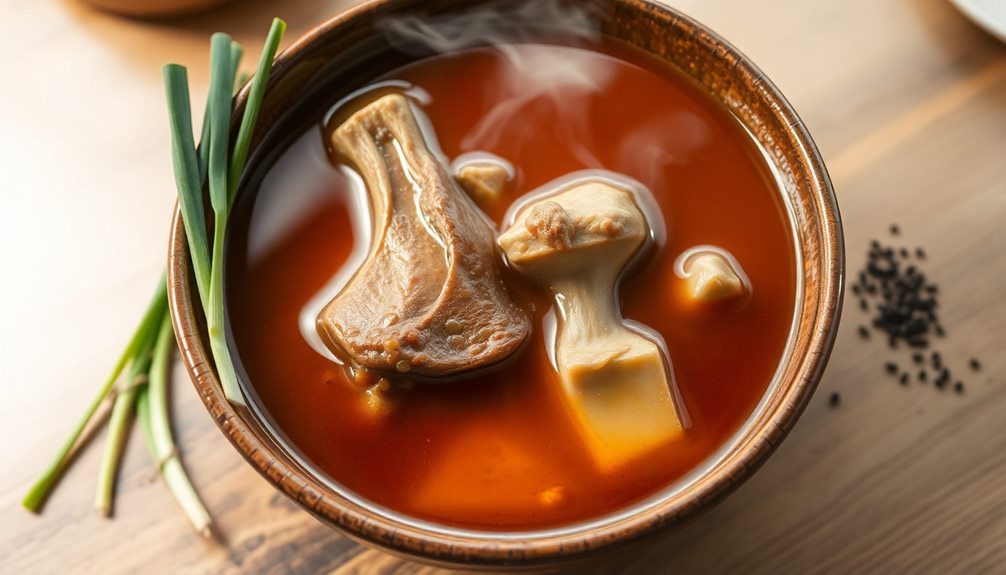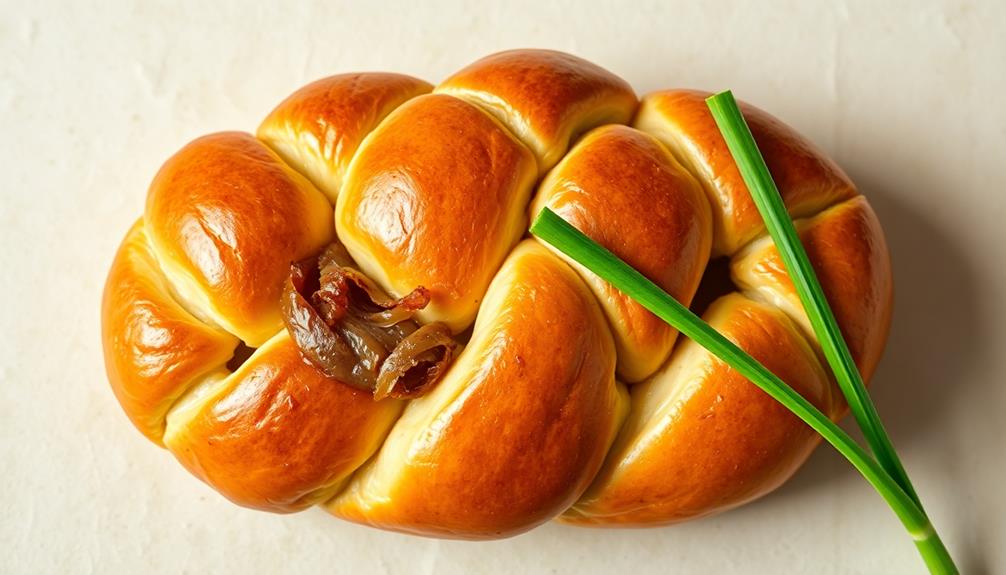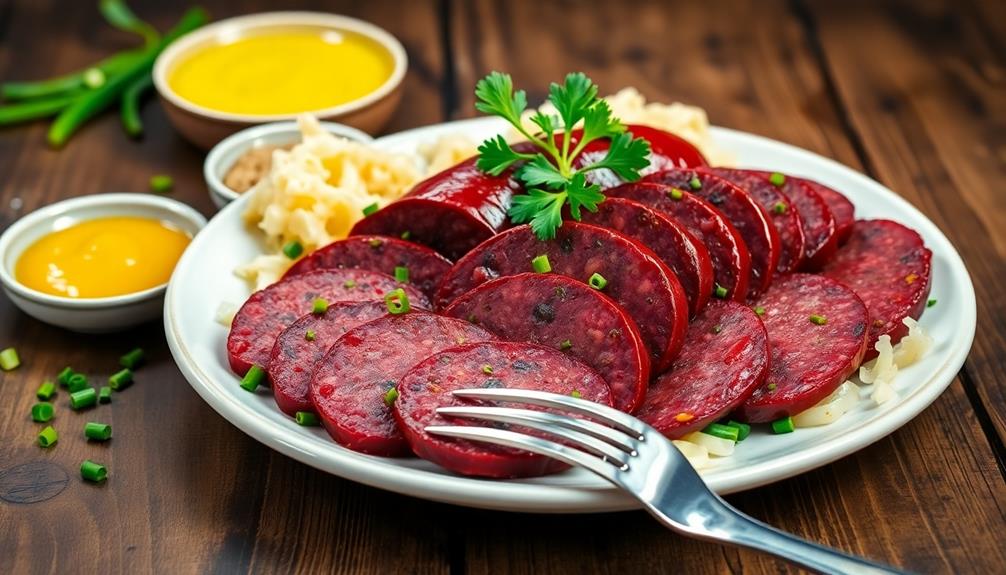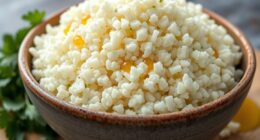If you're a fan of both Korean and Mexican cuisines, you're in for a real treat with these delectable Kimchi Quesadillas! Picture the tangy, spicy kick of authentic Korean kimchi perfectly complemented by the melty goodness of Mexican cheese, all wrapped up in a crispy tortilla. This quick and satisfying meal will have your taste buds dancing with joy. You'll love how the fusion of these two bold flavors creates a unique culinary experience. The best part? It's super easy to make at home. Want to learn more about this exciting crossover of cuisines and how to whip up your own batch?
Key Takeaways
- Kimchi quesadillas combine the tangy, spicy flavors of Korean kimchi with the melted cheese and crisp tortilla of classic Mexican quesadillas.
- The recipe is a quick and satisfying fusion dish that appeals to diverse palates, blending traditional Korean and Mexican culinary elements.
- High-quality, fresh kimchi is essential to enhance the overall flavor and texture of the quesadillas.
- Kimchi quesadillas can be served warm with additional dips or sauces, and are suitable for casual meals or festive gatherings.
- The versatility of quesadillas allows for experimentation with various fillings, catering to different dietary preferences and culinary tastes.
History
Originating in Korea, kimchi has long been a staple ingredient in the country's cuisine. This spicy, fermented cabbage dish is a beloved part of Korean culture, often served as a side or used in various recipes.
Kimchi's history dates back centuries, with evidence of fermented vegetables being consumed in Korea as early as the 3rd century AD. Over time, the recipe evolved, incorporating different vegetables and seasonings to create the wide variety of kimchi we know today.
While kimchi may seem like an unlikely pairing with the classic Mexican quesadilla, the two flavors actually complement each other beautifully. The tangy, crunchy kimchi adds a unique twist to the gooey, cheesy quesadilla, creating a delightful fusion of two beloved dishes.
Whether you're a fan of Korean or Mexican cuisine, the kimchi quesadilla is a delicious way to explore the exciting world of culinary blending.
Recipe
Kimchi, a traditional Korean fermented vegetable dish, meets the quintessential Mexican quesadilla in this delightful fusion recipe. The tangy, spicy flavor of the kimchi perfectly complements the melty, cheesy goodness of the quesadilla. This dish is a unique and satisfying way to enjoy two beloved global cuisines in a single bite.
Preparing this dish is a breeze, making it an excellent choice for a quick and satisfying meal. The combination of the crisp tortilla, gooey cheese, and bold kimchi flavors will leave your taste buds craving more.
- 4 large flour tortillas
- 2 cups grated Monterey Jack or Cheddar cheese
- 1 cup diced kimchi
- 2 tablespoons unsalted butter, divided
Preheat a large skillet or griddle over medium heat. Place one tortilla in the skillet and sprinkle half of the cheese over the surface. Top with half of the diced kimchi, then fold the tortilla in half. Cook for 2-3 minutes per side, or until the cheese is melted and the tortilla is golden brown.
Repeat with the remaining ingredients to make a total of 4 quesadillas.
For best results, use fresh, high-quality kimchi for maximum flavor. The kimchi can be adjusted to taste, depending on your preference for spiciness. Additionally, experiment with different cheese varieties to find your perfect flavor combination.
Cooking Steps
Spread that kimchi all over the tortilla, then sprinkle on the shredded cheese.
Fold the tortilla in half and pop it in the pan until it's golden brown and crispy.
Slice up those quesadillas and get ready to dig in – they're ready to serve!
Step 1. Spread Kimchi on Tortilla
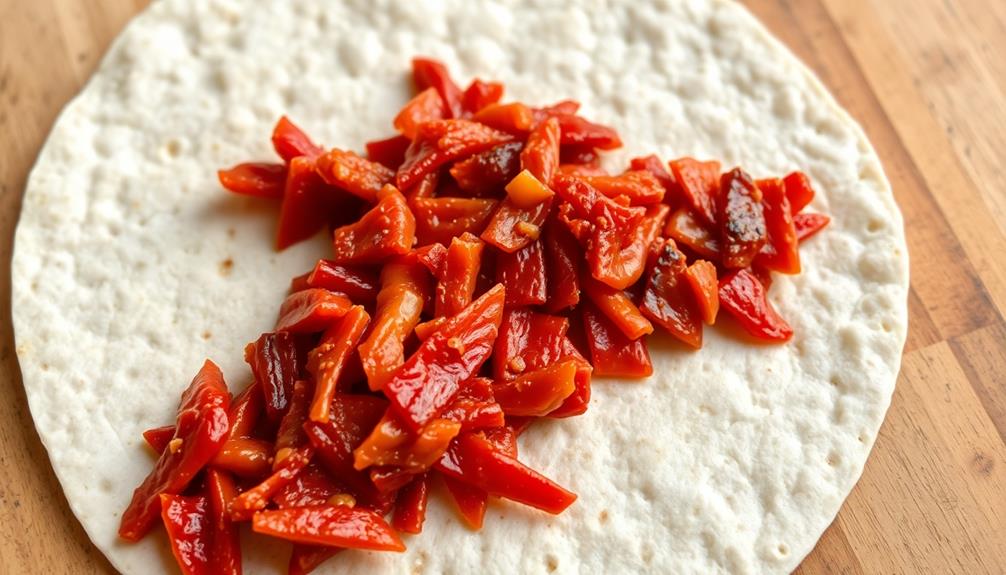
Next, you'll want to generously spread the kimchi over the surface of the tortilla. Don't be shy – pile on that spicy, tangy goodness! The bright, vibrant colors of the kimchi will create a delightful contrast against the pale tortilla.
As you scoop out the kimchi, you'll catch a whiff of its pungent, garlicky aroma, making your mouth water in anticipation. This fusion dish not only tantalizes your taste buds but also offers inspiring keto transformations for those looking to enhance their culinary experience.
Carefully, spread the kimchi all the way to the edges, ensuring each bite will be packed with flavor. The kimchi's crunchy texture will add a satisfying crunch to your quesadilla. Feel free to layer on as much or as little as you'd like, depending on your personal taste preferences.
Once the kimchi is evenly distributed, you're ready to top it with cheese and fold the tortilla in half. Get ready for an explosion of Korean and Mexican flavors in every melty, gooey bite!
Step 2. Add Shredded Cheese
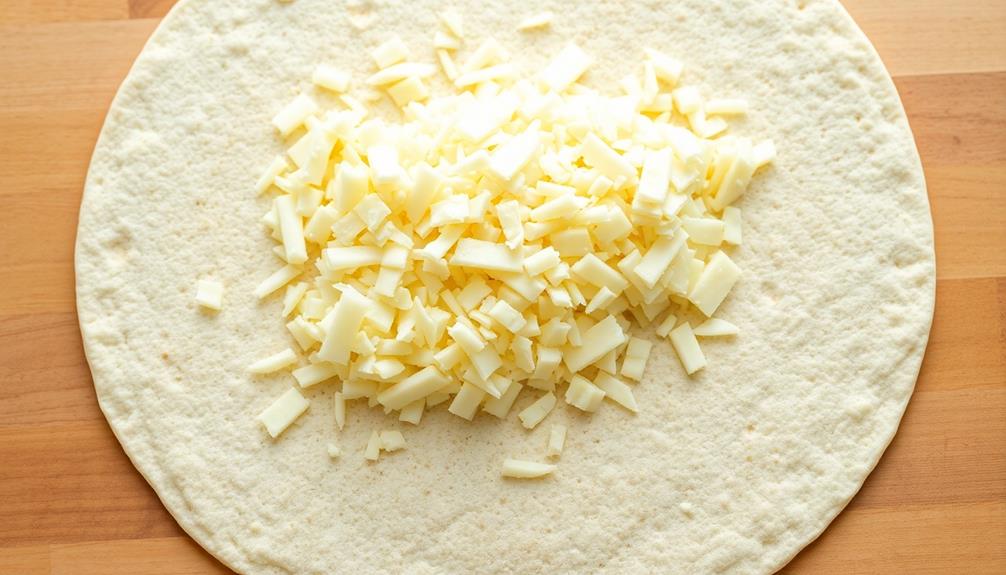
After spreading the kimchi, it's time to add the shredded cheese. You'll want to use a nice, melty cheese like cheddar or Monterey Jack. Grab a handful of the cheese and sprinkle it evenly over the kimchi-covered tortilla.
Make sure to cover the whole surface so every bite has that gooey, cheesy goodness. Don't be stingy – you want a nice thick layer of cheese!
Once the cheese is on, it's time to fold the tortilla in half to create the classic quesadilla shape. Gently press down to help the cheese start to melt.
Now you're ready to pop it in the pan or on the griddle to toast it up. The cheese will get all melty and the tortilla will turn golden brown and crispy.
Mmm, can you just imagine that first bite? The kimchi's tangy, spicy flavor mixed with the creamy, comforting cheese – it's a match made in heaven!
Step 3. Fold Tortilla in Half
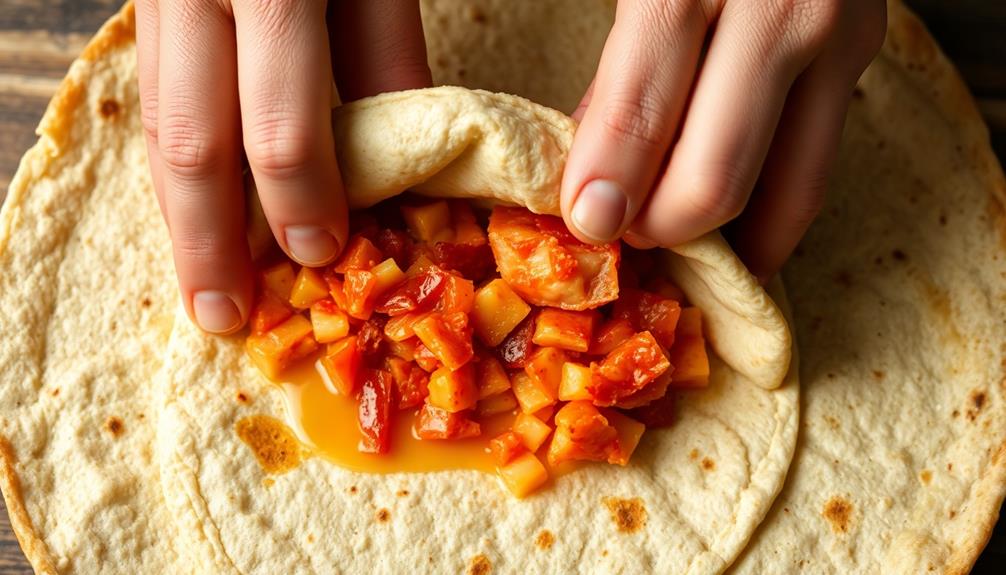
With the cheese evenly distributed, it's time to fold the tortilla in half.
Gently take the top half of the tortilla and bring it over to the bottom half. Press down lightly to seal the two sides together, creating a perfectly symmetrical half-moon shape.
You'll feel the warmth of the melted cheese as the tortilla folds, and see the vibrant colors of the kimchi peeking out from the middle.
Fold with care, making sure not to tear the tortilla. Once folded, you can almost smell the delicious fusion of flavors waiting to be devoured.
The quesadilla is now ready to be cooked to golden, crispy perfection. Flip it over and let the other side sizzle until it's just as irresistible.
Get ready for an explosion of taste in every bite of this unique, mouthwatering creation!
Step 4. Cook Until Golden Brown
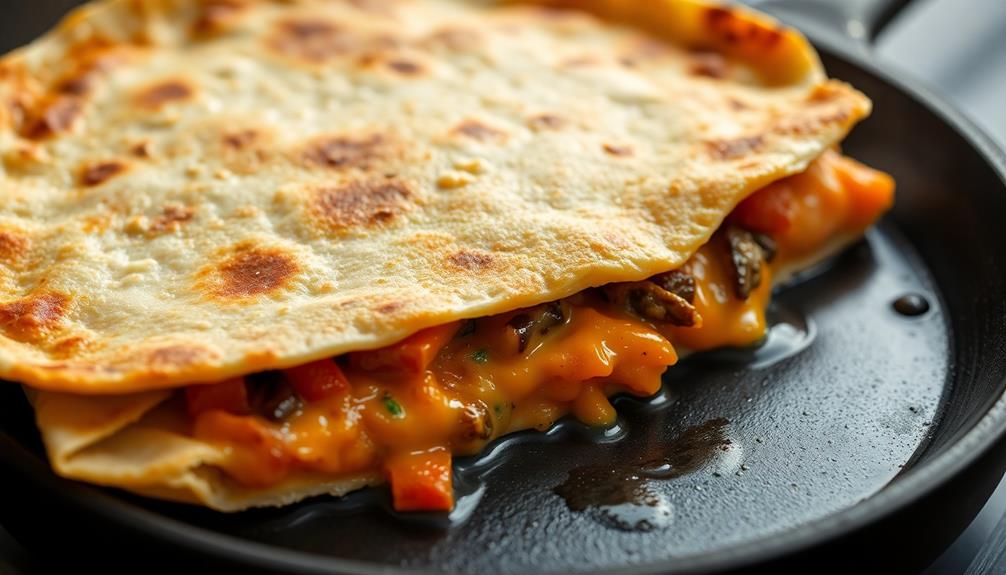
Place the folded quesadilla in a preheated skillet or griddle over medium heat. Listen as it sizzles, filling the air with a tantalizing aroma!
Let it cook for a minute or two, keeping a close eye on it. You'll know it's ready to flip when the bottom turns a lovely golden-brown. Carefully use a spatula to gently flip the quesadilla over. Cook the other side until it's also golden and crispy. The cheese should be melted and oozing out the sides – mmm, delicious!
Once both sides are perfectly cooked, transfer the quesadilla to a cutting board. Slice it into triangles so it's easy to share and enjoy.
The contrast of the crispy tortilla and the warm, gooey filling is simply irresistible. Serve the kimchi quesadillas hot, garnished with extra kimchi, green onions, or a spicy dipping sauce, if desired. Get ready for an explosion of flavors in every bite!
Step 5. Slice Quesadillas Before Serving
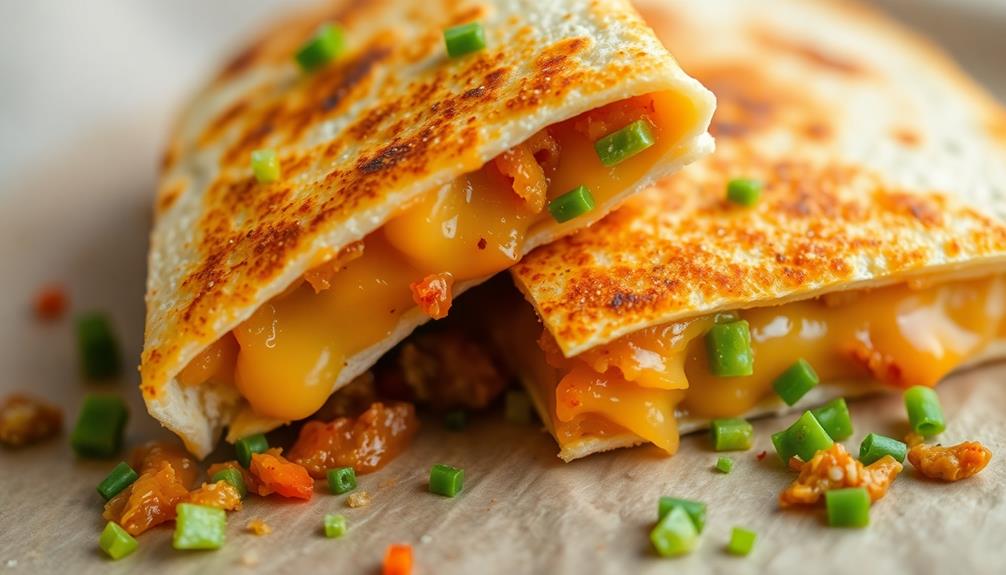
Once you have the perfectly golden-brown quesadilla on the cutting board, it's time to slice it up for easy serving. Using a sharp knife, carefully cut the quesadilla into four or six even triangles. This will make it a breeze for your family and friends to grab a piece and enjoy the delicious combination of crispy tortilla, melted cheese, and savory kimchi.
With the rising popularity of unique flavors and blends in the food industry, this fusion dish is sure to impress your guests, especially those who appreciate health benefits of tea.
Don't be shy about slicing those quarters or sixths – you want everyone to get a nice, hefty portion. The aroma of the toasted tortilla and the vibrant colors of the kimchi peeking through will have your guests' mouths watering and grabbing for a slice as soon as you set the plate down.
Serve the quesadilla triangles warm, and watch them disappear in no time! The perfect balance of spicy, tangy, and cheesy flavors in every bite will have everyone coming back for seconds.
Final Thoughts
As you whip up your kimchi quesadillas, step back and savor the fusion of flavors. The crunch of the tortilla, the zing of the kimchi, and the melty goodness of the cheese – it's a party in your mouth!
You've created a delightful culinary adventure that combines the best of Korean and Mexican cuisines. Consider serving these tasty treats during your next Halloween gathering to impress your guests and add a unique twist to your festivities with Halloween traditions and activities. In addition to your creative fusion, why not offer a spooky twist by incorporating popular Korean kimchi or bulgogi into tacos, adding vibrant color and rich flavors? For an extra surprise, serve Japanese octopus ball snacks (takoyaki) as eerie yet delicious appetizers, perfect for guests intrigued by both Korean-Mexican fusion and popular Japanese street food. These playful dishes will elevate your Halloween celebration and leave everyone raving about the night’s unforgettable feast.
Your friends and family are sure to be impressed by your culinary creativity. Serve the quesadillas with a fresh, crisp salad or some tangy guacamole for a complete meal.
Don't be afraid to experiment with different fillings, like spicy pork or sautéed veggies, to find your perfect flavor combination.
The beauty of this dish is its versatility. Whip up a batch for a casual weeknight dinner or impress guests at your next gathering.
No matter when you enjoy them, these kimchi quesadillas are sure to bring a smile to your face and a happy dance to your taste buds.
Frequently Asked Questions
Is Kimchi Quesadilla a Traditional Korean or Mexican Dish?
Kimchi quesadilla isn't a traditional dish from either Korea or Mexico. It's a creative fusion that combines the tangy, spicy flavor of Korean kimchi with the classic Mexican quesadilla. This unique dish blends elements from both cuisines into a tasty, innovative creation.
Can I Substitute Other Fermented Vegetables for Kimchi?
Certainly, you can substitute other fermented vegetables for kimchi in your quesadillas. Try sauerkraut, pickled carrots, or even fermented beets to add a unique twist to your fusion dish. The possibilities are endless when it comes to experimenting with different flavors.
How Long Does It Take to Make Kimchi Quesadillas?
Making kimchi quesadillas doesn't take long – you can whip them up in around 30 minutes. Start by sautéing the kimchi, then assemble the quesadillas and cook them on the stovetop until the cheese is melted and the tortillas are crispy.
Can I Use Store-Bought Kimchi for This Recipe?
Absolutely! You can use store-bought kimchi for this recipe. It'll save you time, and the bold, tangy flavors of the store-bought kimchi will still work perfectly in your quesadillas. Feel free to use your favorite brand.
What Type of Cheese Works Best in Kimchi Quesadillas?
Sure, you can use store-bought kimchi for your quesadillas. As for the cheese, go for a melty variety like cheddar, Monterey Jack, or Mexican blend. These cheeses will complement the tangy, spicy flavors of the kimchi perfectly.


